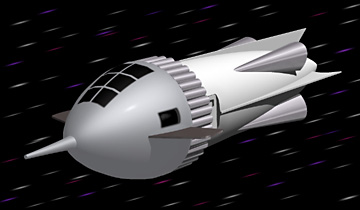
To Open The Sky
THE QUEST SO FAR

Flash Gordon's spaceship speeding through the void
Copyright © ???? Edward Rowles
http://www.starships.com/
Rockets have been around for over two thousand years. But it was only on the verge of the Twentieth Century that anyone worked out the theoretical basis of launching ships into space. (That "anyone" was a Russian schoolteacher named Tsiolkovsky. His story is found in The Birth of Rocket Science.)
Tsiolkovsky developed the rocket equation, proposed liquified oxygen and hydrogen as propellants, and understood the necessity of using staged vehicles. But his work was entirely theoretical. It fell to the next generation of Russian scientists and technicians to put it to use. In the U.S., quite independently, Robert Goddard arrived at the same theories. He went on to build actual hardware. (Indeed, Goddard's work led to renewed interest in Tsiolkovsky, as well as inspiring German experimenters who formed the core of the Peenemunde team during World War 2.)
Goddard was, with some justification, mistrustful of collaboration and performed his experiments with just a small crew of technicians in the wilds of New Mexico. For this and other reasons he did not have as big an impact in America as he might have. The result was that the Second World War found Germany far ahead in developing large rockets. The Soviet Union also lagged the Reich. But there it was more because of political interference and infighting; grassroots interest in rocketry was widespread. After V-E Day, both victor nations took the German example to heart and began serious work. Soon a new urgency arose; they began to compete in missile development. The Cold War was under way.
This competition led to the situation we have today. The natural progression from prop planes to jets, then to supersonic aircraft reaching ever higher Mach numbers and altitudes would have produced a reusable space vehicle of some sort. But the Cold War heated up, and the Russians kept racking up wins with their big rockets: Sputnik, Laika, Yuri Gagarin, Valentina Tereshkova. President Kennedy's decision to make the moon landing first brought about an enormous American achievement, of which we can be forever proud. But it also aborted spaceplane development at the X-15 stage. Kennedy's timetable could not allow such incremental progress; he had to go for broke. The X-15 way was the surer (and less costly) way. The quick way was to base the Mercury, Gemini and Apollo launchers on missile designs: throwaway vehicles. Then, when the Russians were well and truly beaten by Apollo 11, and with other things (Viet Nam, the War on Poverty) demanding more resources, space was cut back. The last three Apollo missions were cancelled, their Saturn V launchers left to rot in the rain. The grand design of missions to Mars launched from 500-person space stations served by fully reusable shuttles faded away. True, we did get the Space Shuttle. But that turned out to be a less than optimum solution.
Remember a movie called 2001? Back in 1968 when it was released, that set the mark for what we expected to be doing in space by the year 2001. Reality turned out to be somewhat different. Today we find ourselves with a space program noteworthy for spending more and more to achieve less and less. The reasons why we've fallen short of those grand dreams are complex. The dreams, however, are still as valid as they were in prior years.
Everything we've seen in the decades since 1968 tells us the public interest in space remains strong. Millions watched the Pathfinder Mission on Mars through its Web site, and that was just a robot. Quite aside from all the "serious" things we might be doing in space, there's a market for space tourism. Trust me; when people spend $100,000 for a world cruise, when they vacation in Antarctica, they'd drop some serious dough on space voyages if the cost dropped to where it was merely extravagant.
The key to tourism and all the other projected space activities is radically lowering the cost of getting to orbit. That's just what the major aerospace companies have promised us, these past forty years, and what they have failed to deliver. They really have no strong incentive to undertake the effort. But fortunately there are upstart companies who do.

